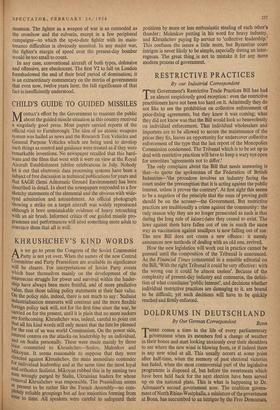MUSEUM PIECE
nHE embarrassing but indisputable fact,' a Spectator leading 1 article complained twelve months ago, 'is that in spite of all the money and effort poured into the production of con- ventional weapons since the war, the RAF and the Navy are worse off for them today than they were in 1946.' A glance at the Government's Defence Statement for the present year reveals that the position is now, if anything. worse.
To take one example: incredible though it may sound. the Government is still thinking of air defence in terms of Javelins, Hunters and Swifts. Many months ago the Hunters, admirable aircraft though they were, were on the suspect list; partly because of the discovery of the need for endless modifications, partly because they could not fire their guns at high altitudes without the risk of serious damage to their structure. As it was unlikely that the enemy would play the game and come in at medium altitudes, the Hunters' useful- ness as a weapon of war was consequently limited to the hope that the pilots of enemy bombers might get heart attacks at the sight of them.
It might have been expected, then, that unless remedies were quickly forthcoming. the Hunter would be removed from service. But only last week. the Manchester Guardian's Defence Correspondent. visiting a fighter station. was still reporting that 'half the Hunters there are grounded awaiting servicing or modifications, and those which can fly may not fire their guns at high altitude.' According to the Defence Statement, orders for Hunters have at last been reduced; and orders for the Swift fighter `have nearly all been cancelled.' The 'nearly' is interesting; for only a couple of days after the Statement appeared it was reported that the first British guided missile, the Fireflash. is to be fitted in the Swift. The Swift, it will be remembered, was rejected as a fighter some months ago because—it was under- stood—it lacked the necessary speed. It seems, then, that British fighter aircraft now fall into two main categories: those which may be fast enough to catch an enemy bomber but can't fire at it; and those which could fire at it but can't catch it.
There is little need for worry, however, because even if the snags which have beset our fighters were cleared up overnights they would still be fit for little better than a sojourn in a museum. The fighter as a weapon of war is as outmoded as the crossbow and the culverin, except in a few peripheral
hfe
campaigns—to which the up-to-date figr with its main- tenance difficulties is obviously unsuited. In any major war, the fighter's margin of speed over the present-day bomber would be too small to count.
In any case, conventional aircraft of both types. defensive and offensive, are obsolescent. The first V2 to fall on London foreshadowed the end of their brief period of domination; it ry
is an extraordinary commentary on the inertia of governments that even now, twelve years later, the full significance of that fact is insufficiently understood.



































 Previous page
Previous page